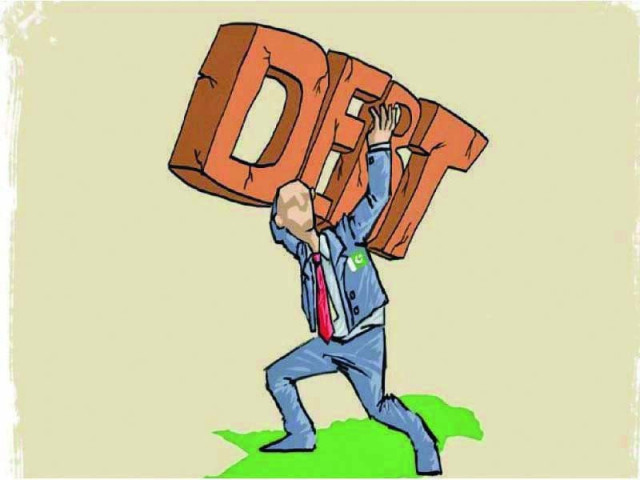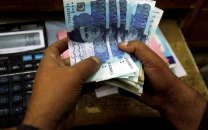Debt servicing to take lion’s share in budget
Govt may unveil fiscally expansionary budget of around Rs14.6tr for FY 2023-24

The government may unveil a fiscally expansionary budget of around Rs14.6 trillion – an unprecedented 50% increase over this’s year’s approved budget – mainly on account of a record high interest payments.
Sources told The Express Tribune that for fiscal year 2023-24, budget deficit – gap between expenses and the income – is estimated at around 7.4% of the gross domestic product (GDP). This is quite large but is still around 0.7% of GDP less than the revised deficit for the outgoing fiscal year.
Alarmingly, slightly over half of the bloated budget outlay will be earmarked for paying the interest cost.
After adding the demanded defence budget by the Ministry of Defence, the federal government may spend around 64% of the budget on debt servicing and defence, the sources said.
Finance Minister Ishaq Dar on Monday took the first presentation on fiscal year 2023-24 budget, which he wants to present in the National Assembly on June 9.
In the rupee terms, the federal budget deficit could be Rs7.8 trillion. If set at that level, the federal deficit will be nearly three-fourth higher than the original deficit target of this fiscal year.
The numbers are subject to changes proposed by the finance minister and the federal cabinet before its presentation to the cabinet.
The federal primary deficit – calculated after paying interest cost – could be 0.3% of the GDP. But it is still better than 0.7% of the GDP primary budget estimated for this fiscal year.
The sources said that the overall primary budget might be shown slightly positive on the back of provincial cash surpluses. The overall budget deficit could be around 6.9% of the GDP or Rs7.3 trillion.
The Ministry of Finance suggested an increase in the salaries of employees by 20%. But Dar deferred the matter, saying that the federal cabinet would take the decision. The finance minister also instructed reviewing the proposed allocation of Rs700 billion for the development spending in the next fiscal year, the sources added.
The budget numbers remain tentative amid the Ministry of Planning’s failure to hold a meeting of the National Accounts Committee (NAC) for the approval of the outgoing fiscal year’s provisional economic growth figure.
The planning ministry has thrice postponed the scheduled NAC meeting that has given rise to apprehension of manipulation of the economic growth figure that according to some initial reports was in the negative territory. Even based on the SBP model, the growth rate for this fiscal year was slightly positive by 0.2%.
For the outgoing fiscal year, the National Assembly had approved Rs9.6 trillion budget. The sources said that the budget outlay for fiscal year 2023-24 might surge to Rs14.6 trillion – higher by Rs5 trillion or over 50%.
The key reasons behind the expansionary fiscal policy amid looming default risks are higher allocations for interest payments, defence spending and no real increase in the FBR’s tax-to-GDP ratio.
The sources said that the allocations for the interest payments may remain around Rs7.5 trillion – higher by Rs3.5 trillion or 87% against this year’s approved budget. The central bank has significantly increased the interest rates to 21% and as a result, half of next fiscal year’s ballooned budget will be consumed on these payments. The rupee devaluation is another factor behind record interest payments.
The sources said that the Ministry of Finance wanted Rs1.7 trillion allocation for the stated defence budget but the Ministry of Defence demanded Rs1.92 trillion.
If the defence ministry’s demand is met, the next year’s defence budget will be one-fourth or around Rs360 billion higher than this fiscal year’s approved budget.
The inflation in April skyrocketed to 36.4% -- 59 years’ highest level. The average inflation rate is now projected to stay around 21% in the next fiscal year. The budget figures suggested that the International Monetary Fund might not have endorsed such an expansionary fiscal outlay, which would further contribute to the overall debt burden of the country.
The gross federal government revenues are estimated at Rs11.8 trillion – higher by 25% or Rs2.3 trillion over the original budget. After paying the shares of the provinces, the net revenues of the federal government are projected at Rs6.5 trillion, according to the sources.
The FBR’s tax target is projected at Rs9.2 trillion -- up by 24%. But in terms of size of the GDP, it is equal to only 8.7% and not enough to contain the growing public debt and finance the expenses.
The sources said that the FBR also presented key taxation measures for the next fiscal year, which revolved around documenting the businesses, including discouraging the growing trend to become a filer to avoid higher tax rates just before conducting a major transaction.
No increase in the tax burden of the salaried class was proposed. The FBR suggested to the finance minister that around Rs350 billion incremental impact of the taxation measures taken in February this year will also be realised in the next fiscal year.
Taxing the foreign exchange income pool of the commercial banks also remains on the list of the FBR, including restoration of withholding tax on cash withdrawals.
The planning ministry also demanded Rs1.2 trillion for development spending but the finance ministry has so far allocated Rs700 billion. The sources said the finance minister has instructed to review the proposed Rs700 billion allocation.
The subsidies are estimated over Rs1.2 trillion while another amount of over Rs1.2 trillion is estimated on account of various grants, including electricity and gas.
An official handout of the finance ministry stated that Dar chaired a meeting on budgetary proposals presented by the FBR. The finance minister reiterated the resolve of the government to provide a business and people friendly budget, according to the statement.
He added that the government is committed to ensure that the new budget brings economic prosperity for all sectors of the economy and ensures distribution of resources equitably among various sectors.



















COMMENTS
Comments are moderated and generally will be posted if they are on-topic and not abusive.
For more information, please see our Comments FAQ